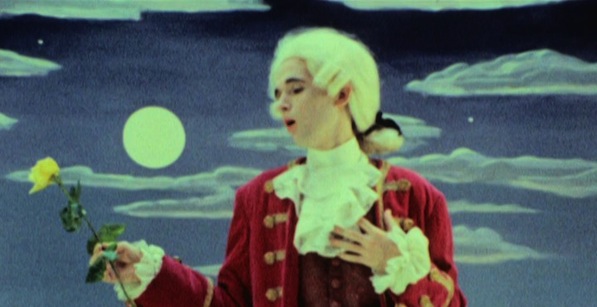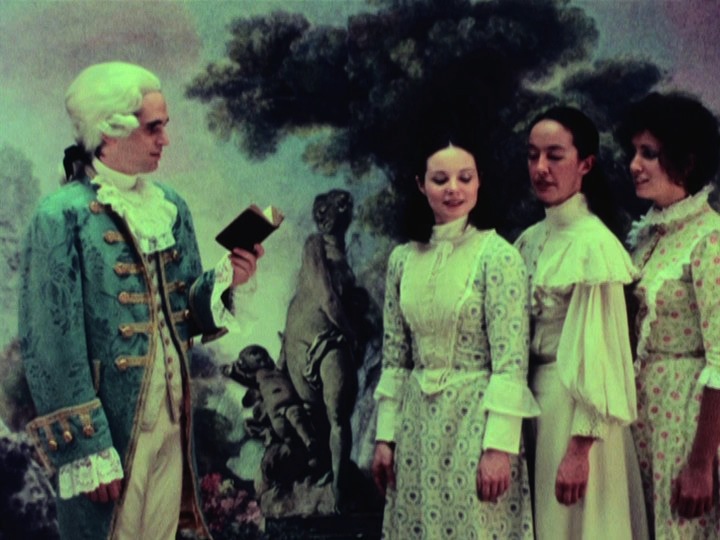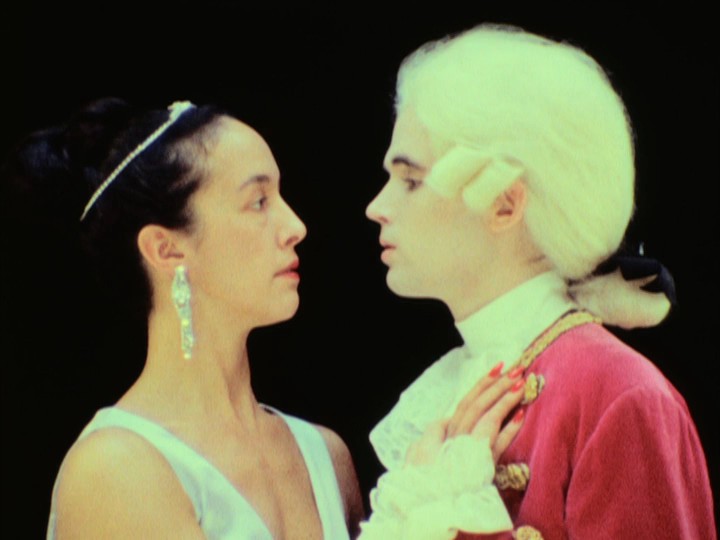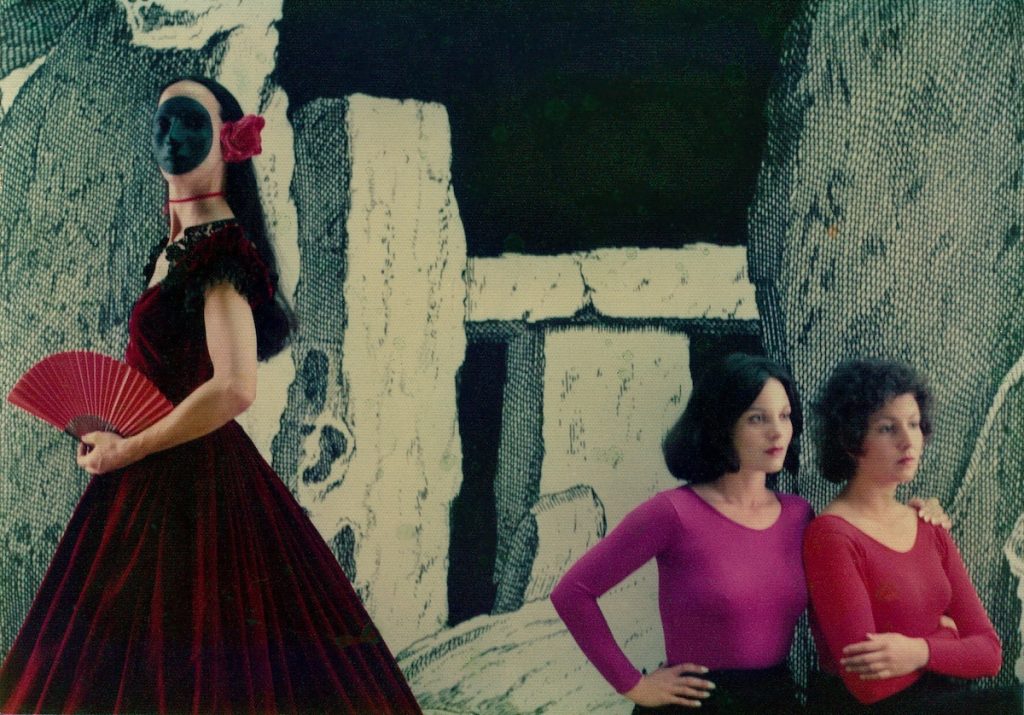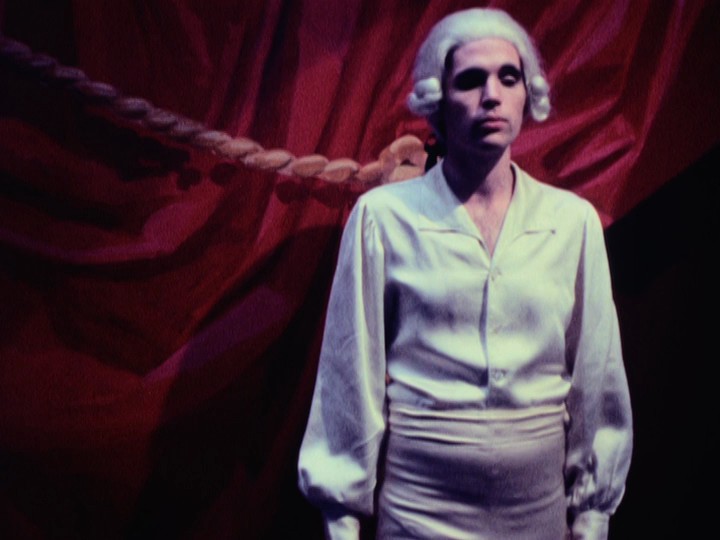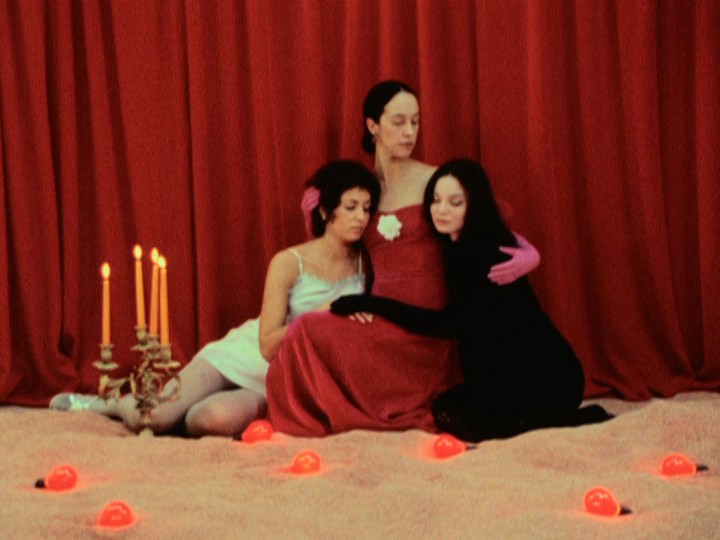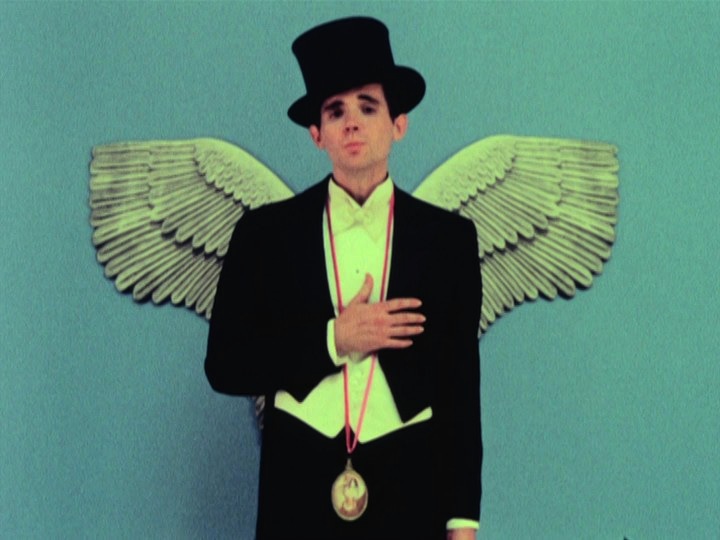Mark Rappaport has always enjoyed inhabiting other people’s autobiographies—partly, no doubt, as he makes clear in his Mark Rappaport: The TV Spin-Off (1980), to avoid having to parade his own. In the 1990s, he was celebrated for his imagined self-portraits of Rock Hudson (Rock Hudson’s Home Movies, 1992) and Jean Seberg (From the Journals of Jean Seberg, 1995), works that mixed acted monologues with video technology effects. In 2013, similarly styled evocations of the lives and times of showbiz celebrities including Greta Garbo and Alfred Hitchcock filled his self-published collection (F)au(x)tobiographies—a follow-up to his The Moviegoer Who Knew Too Much (2012, French edition 2008), which assembled essays he has written since 2001 for magazines including Rouge, Film Quarterly, Cinéma, Heat, and Trafic.
But this line of investigation began much earlier in Rappaport’s career. Mozart in Love (1975, U.S.A.), his second feature—in the remarkable string of off-beat, experimental narratives that runs from Casual Relations (1974) to Chain Letters (1985)—takes off from the deliberate anachronism of using modern props, performance styles, and attitudes to evoke the 18th-century romantic entanglements of the young Wolfgang Amadeus Mozart (Rich La Bonte) with three sisters, Constanza (Margot Breier), Sophie (Sasha Nanus), and Louisa (Sissy Smith). We enter Mozart’s mind—he is fond of making grandiloquent statements like “music is all, love is all”—and the minds of each woman, in turn.
The film traces itself out like a diagram. Mozart falls for the eldest sister, Louisa, but she does not love him back. The youngest one, Sophie, loves Mozart, but this is a further instance of unreciprocated longing. The prodigious composer ends up settling for the middle sister, Constanza. The rivalry, intended or inevitable, among the women leads first to separations and later to reunions—but both the freeze-out and the reconciliation are presented to us as weird tableaux of “acting out,” people unconsciously seeking and taking up their roles in an age-old, pre-written tale. They suffer nobly, love honorably, die beautifully. Or, at least, they think they do, in their heads—and in the exterior projection of those mental images that Rappaport so ironically and bitingly devises.
The writing here—and the speaking of lines (mainly in voice-over) by actors—has a unique quality. As always in Rappaport’s work, whatever the medium, the “voice” is both singular (no one but him could have scripted it), and a cultural patchwork: his characters express themselves in a confessional stream of consciousness that evokes, all at once, classic Hollywood clichés, the self-help jive of therapy television, and the thousand and one, convoluted justifications that arise from an intellectual, cultivated milieu (so there’s even an occasional Woody Allen echo in there). The self does not exist; it is an illusion, a construction, a weave from what Roland Barthes once called the “innumerable centers of culture.” Rappaport’s feature films of this period simultaneously evoke and undercut appeals to our emotional response: they show how easy it is to get sucked into sentimental clichés, while providing numerous doorways out of the trap.
The melodramatic plot of rejection, pining, and sacrifice in Mozart in Love may have its basis in reality, but everything else is strictly stylized. (Rappaport, for instance, edits out a fourth sister, Josepha, from the real-life story of the Weber family.) From his early shorts, such as Mur 19 (1966) and Blue Streak (1971), Rappaport followed his temperamental (as well as theoretical and artistic) aversion to any kind of realism in cinema. In the case of Mozart of Love (which has been restored thanks to the efforts of George Eastman House), two historical periods—now and then—mutually “alienate” each other and make everything strange. Time-markers of the seventies—a stroll down a New York street, a drive in a car, a meeting in a café—come to look just as odd as all the wigs, masks, costumes, and exotic backdrops that, in their mix-and-match combinations, signify the past.
In the seventies, Rappaport developed a barrage of anti-realist techniques that he refined from piece to piece. Filming most interiors in his own New York loft of the period (he has since lived, for over a decade, in Paris), he strips the pictorial elements down to their essentials: a wall painted with one primary colour (sky blue, lime green, pink), or covered in a decorative paper pattern; actors in mainly static poses, occasionally breaking to reconfigure their arrangement, shift the direction of their gaze, or produce a Brechtian-style gesture. Above all, there is the use of blown-up photographs or projected, moving images as backdrops, sometimes more eye-catching than the performers themselves: elements of nature, like water or clouds, otherwise completely banished from the artifice of the loft-set, make their sly appearance, between quotations marks as it were, here.
The camera position in these interiors is almost always frontal, theatrical; Rappaport prefers the distance of wide, group shots and two-shots over individual close-ups, and largely eschews editing for the sake of sustaining his tableaux in long takes. (In an on-set report about Imposters for American Film by Jonathan Rosenbaum in 1979, Rappaport declared: “Since Casual Relations, I use as little editing as possible, because I know the more you can get a scene to work with the least editing, the more you’re really in control of the situation.”) The images, like the verbalizations offered on the soundtrack, are also artful collages woven from all over: Egyptian pyramids clash with a Fred Astaire-trademarked top hat and tails—and the three sisters wear T-shirts emblazoned with (respectively) a heart, a star and lips with a cigarette dangling.
One might not imagine, from what I have said so far, that Mozart in Love is, predominantly, a film comprised of musical performances. In this respect, it is unlike anything else Rappaport has made. Mostly Mozart’s arias (selections from The Abduction from the Seraglio, Cosi Fan Tutte, Don Giovanni, The Magic Flute, and The Marriage of Figaro), plus a little Berlioz and Gluck thrown in for good measure—not to mention a delicious blast of “Two Little Girls From Little Rock” from Gentlemen Prefer Blondes (1953). Perhaps influenced by the example of Jean-Marie Straub and Danièle Huillet’s The Chronicle of Anna Magdalena Bach (1968), the arias are given to us in long, often complete chunks—and then separated by short bursts of voice-over musing. The film gives over so much time and space to this music not only for its inherent pleasure as spectacle, but also because, on diverse levels, the lyrics seem to have both emerged from Mozart’s personal experience with the three Weber sisters (at times providing very lightly veiled re-enactments of autobiographical material), and now provide an excellent, further level of ironic commentary upon how Mozart (and the culture around him) conceived of love, marriage, sisterhood, and so on.
But the musical performances, too, are made strange. In the first place, by being mimed—and Rappaport shows us both a 12″ vinyl record (label name: Angel) being played, and an opening montage of the actors diligently rehearsing to playback provided via humble tape recorders. In the second place—and more decisively—with this playback frequently interrupted and replaced by the raw audio track of real, untrained singing; a tactic that anticipates Werner Schroeter’s goading of Isabelle Huppert into trying her hand at an aria in the recording studio during the making of his own, remarkable, avant-garde tribute to opera, Love’s Debris (1996). (Aside: although few names in the credits of Mozart in Love reappear in subsequent movies, “live sound” guy Lawrence Loewinger has enjoyed a distinguished film and TV career working for Spike Lee and Abel Ferrara, among many others.)
Rosenbaum described Mozart in Love in 1979 as “virtually an equivalent to a guided gallery tour of singing paintings”—but there is more going on than simply a Peter Greenaway-style “cinematization” of High Art icons. The film belongs to a lively family of American works that pre-date the official rise of “indie” cinema and its commercial networks that began with Jim Jarmusch’s Stranger Than Paradise (1984). Peter Wollen and other commentators in the art journal October, in the early eighties, called this pre-indie movement “The New Talkies”—partly because so many words (and so much in voice-over) were usually involved. Filmmakers including Rappaport, Rainer, Babette Mangolte, Jon Jost, Michael Oblowitz, Chantal Akerman (in News from Home, 1976), James Benning and (from an earlier generation) Michael Snow all worked with extremely low budgets and made pieces that were deceptively minimalistic: in the best cases, the films crackled with ideas, provocations, and new ways of combining images, sounds, performances, and fragments of fiction. Their approach found comrades in many cinematic “undergrounds” across the world.
Some of these films, frequently at feature (sometimes very long feature) length, tended to fall—and this is especially true of Rappaport—into what Rosenbaum (in his invaluable book Film: The Front Line 1983) called “that dreaded no man’s land between the avant-garde and the mainstream.” Later, in the post ’84 age of the indie (which still reigns, more or less, today), certain strands of experiment were gingerly retained—Hal Hartley’s droll style, for instance, seems to owe much to Rappaport’s cool moves—but the full import of what was previously at stake was largely lost.
This is what I mean. All the “new talkies” were heavily marked, not only by the oppositional, Marxist, feminist and queer politics of the 1960s and seventies, but also by the intellectual rise of semiotic and psychoanalytic theories. Everything once deemed “natural” or commonsensical—from gender/sex roles and the capitalist economy, to inner, subjective emotions and language itself—had to be dismantled. The heady mix of avant-garde technique and revolutionary theory offered, for a brief but busy time, the best way to implement this program. But, beyond the sometimes laborious or mechanical way that such theories were applied to filmmaking, the combo of ideas and experimentation regularly produced works that were funny, funky, challenging and durable.
Talk of the “subject in process”—the individual character (or spectator) shifted through multiple identifications and positions, never settling into merely one, conventional identity—was all the rage back then; but the need for such a radical and fundamental shake-up has not disappeared with the ebbing of a particular intellectual-cultural “fashion” or era. Many of these films now await rediscovery.
To some viewers unfamiliar with this historical context, and the rich “intertext” of films it produced, Mozart in Love may seem like a communiqué from an ancient, distant, quite alien planet. Why such irony, such mockery, such ambivalent love/hate for everything that opera (and romantic cinema, literature or art in general) has bequeathed to us? In the career of Mark Rappaport (and he has remained true to this impulse since the 1960s), the diverse elements and levels—distaste for realism, love of artifice and that deconstructive, anti-ideological agenda—click together with a rare vibrancy and aesthetic coherence. For him, the ideological myths we internalize, the soap operas we live, have to be exposed and satirized—just as the constructed illusion we call filmic realism has to be relentlessly taken apart at every turn. Fortunately for us, Rappaport has been able to build something solid and lasting upon such shifting sands of political and personal passion. Mozart in Love offers a handy checklist of the many acute, often hilarious games of disenchantment devised by this ever-inventive artist.

